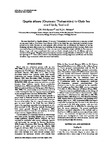<i>Upogebia deltaura</i> (Crustacea: Thalassinidea) in Clyde Sea maerl beds, Scotland
| dc.contributor.author | Hall-Spencer, Jason | |
| dc.contributor.author | Atkinson, RJA | |
| dc.date.accessioned | 2013-02-20T12:22:06Z | |
| dc.date.available | 2013-02-20T12:22:06Z | |
| dc.date.issued | 1999-10 | |
| dc.identifier.issn | 0025-3154 | |
| dc.identifier.issn | 1469-7769 | |
| dc.identifier.uri | http://hdl.handle.net/10026.1/1364 | |
| dc.description.abstract |
<jats:p>Burrows inhabited by <jats:italic>Upogebia deltaura</jats:italic> (Crustacea: Thalassinidea) were studied over a two-year period on two maerl beds at 10 m below Chart Datum (CD) in the Clyde Sea area, Scotland. Labelled burrows proved to be stable features on each ground, with animals able to withstand the impacts of scallop dredging and storm disturbance by re-building the damaged upper sections of their burrows. Resin casts excavated using an air-lift showed that these burrows were inhabited by single individuals. Burrows were deeper, larger and more complicated than was previously thought typical for <jats:italic>U. deltaura</jats:italic> and other members of the genus. Mapping of burrow systems revealed average densities of 2.9 ind m<jats:sup>−2</jats:sup> with up to ten openings m<jats:sup>−2</jats:sup>. These elusive animals were the deepest burrowing megafauna (to 68 cm) and the most abundant large crustaceans within the maerl bed habitat.</jats:p> | |
| dc.format.extent | 871-880 | |
| dc.language | en | |
| dc.language.iso | en | |
| dc.publisher | Cambridge University Press (CUP) | |
| dc.title | <i>Upogebia deltaura</i> (Crustacea: Thalassinidea) in Clyde Sea maerl beds, Scotland | |
| dc.type | journal-article | |
| dc.type | Journal Article | |
| plymouth.author-url | https://www.webofscience.com/api/gateway?GWVersion=2&SrcApp=PARTNER_APP&SrcAuth=LinksAMR&KeyUT=WOS:000083210200008&DestLinkType=FullRecord&DestApp=ALL_WOS&UsrCustomerID=11bb513d99f797142bcfeffcc58ea008 | |
| plymouth.issue | 5 | |
| plymouth.volume | 79 | |
| plymouth.publication-status | Published | |
| plymouth.journal | Journal of the Marine Biological Association of the United Kingdom | |
| dc.identifier.doi | 10.1017/s0025315498001039 | |
| plymouth.organisational-group | /Plymouth | |
| plymouth.organisational-group | /Plymouth/Faculty of Science and Engineering | |
| plymouth.organisational-group | /Plymouth/Faculty of Science and Engineering/School of Biological and Marine Sciences | |
| plymouth.organisational-group | /Plymouth/PRIMaRE Publications | |
| plymouth.organisational-group | /Plymouth/REF 2021 Researchers by UoA | |
| plymouth.organisational-group | /Plymouth/REF 2021 Researchers by UoA/UoA07 Earth Systems and Environmental Sciences | |
| plymouth.organisational-group | /Plymouth/Research Groups | |
| plymouth.organisational-group | /Plymouth/Research Groups/Marine Institute | |
| plymouth.organisational-group | /Plymouth/Users by role | |
| plymouth.organisational-group | /Plymouth/Users by role/Academics | |
| dc.identifier.eissn | 1469-7769 | |
| dc.rights.embargoperiod | Not known | |
| rioxxterms.versionofrecord | 10.1017/s0025315498001039 | |
| rioxxterms.licenseref.uri | http://www.rioxx.net/licenses/all-rights-reserved | |
| rioxxterms.type | Journal Article/Review |


